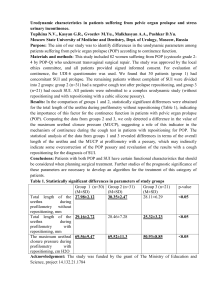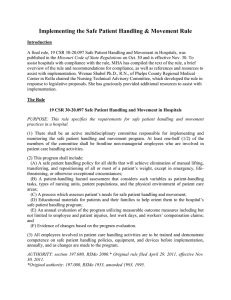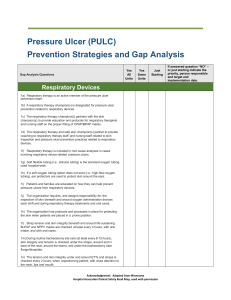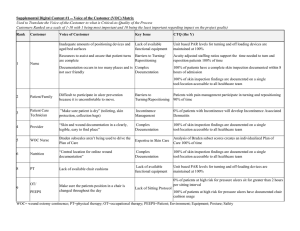Elevating Repositioning Costs: Strategy Dynamics and Competitive Interactions in Grand Strategy
advertisement
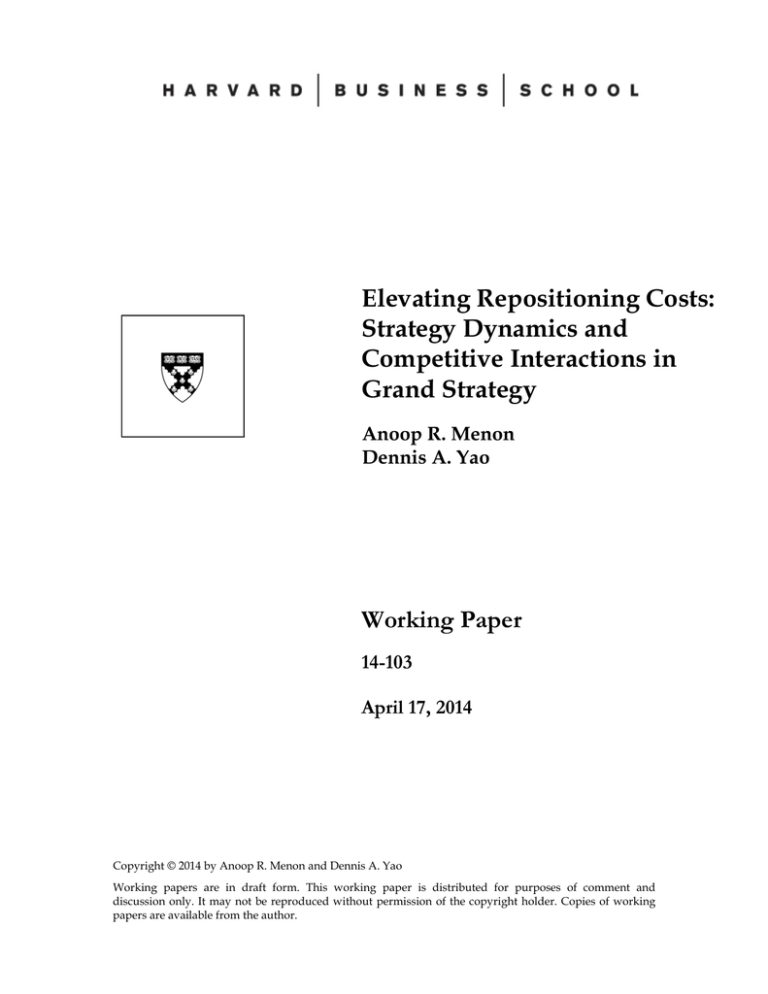
Elevating Repositioning Costs:
Strategy Dynamics and
Competitive Interactions in
Grand Strategy
Anoop R. Menon
Dennis A. Yao
Working Paper
14-103
April 17, 2014
Copyright © 2014 by Anoop R. Menon and Dennis A. Yao
Working papers are in draft form. This working paper is distributed for purposes of comment and
discussion only. It may not be reproduced without permission of the copyright holder. Copies of working
papers are available from the author.
Elevating Repositioning Costs:
Strategy Dynamics and Competitive Interactions in Grand Strategy
Anoop R. Menon and Dennis A. Yao1
April 17, 2014
Abstract
This paper proposes an approach for modeling strategic interactions that incorporates the costs to
firms of changing their strategies. The costs associated with strategy modifications, which we
term “repositioning costs,” constitute a defining feature of strategic choice which is particularly
relevant to interactions involving grand strategies. Repositioning costs can critically affect
competitive dynamics by making strategies “sticky” and, consequently, the implications of
strategic interaction for strategic choice. And yet, while the organization and strategy literatures
broadly recognize the importance of repositioning costs, game-theoretic treatments at the grand
strategy level with very limited exceptions have not focused on them. In this paper we argue for
greater recognition of repositioning costs, provide a repositioning cost typology, and demonstrate
the fertility of this approach with a simple model of inter-firm competitive interaction in which
repositioning costs increase with the length of time that a firm has been executing its current
strategy.
1
The Wharton School, University of Pennsylvania, Philadelphia, PA 19104,
armenon@wharton.upenn.edu, and Harvard Business School, Boston, MA 02163, dyao@hbs.edu. The
authors thank Pankaj Ghemawat, Hillary Greene, Rich Makadok, David Yoffie and seminar participants
at HBS and the CRES Conference on the Foundations of Business Strategy, Washington University, for
helpful comments.
Elevating Repositioning Costs
2 1. Introduction
Strategic change is daunting. To go “all in” requires a commitment to developing new
capabilities and integrating those capabilities across the activity system of the firm, while
abandoning existing systems that either do not support or actively undermine the strategic
change. The costs involved with such change—what we call repositioning costs—can be
analyzed from the viewpoint of the focal firm itself, but a full assessment of the benefits of
strategic change requires, among other things, assessing future moves and countermoves of the
focal firm and its rivals. Understanding these strategic dynamics, especially when assessing
grand strategy, requires consideration of repositioning costs. This paper constitutes an initial
attempt to both elevate and formalize the role of repositioning costs within analyses of grand
strategy.
The approach proposed incorporates repositioning costs into game theoretic models of
grand strategy. The repositioning costs we contemplate include those associated with strategic
changes to a firm’s market position or its configuration. Such costs reflect a change to a firm’s
activity system (Porter, 1996) and reflect myriad factors including the similarity between the old
and new activity systems, the length of time during which the previous activity system was
employed, and the difference in the resources needed to support each position. Repositioning
costs are, therefore, path dependent.2
Our focus on repositioning costs reflects Pankaj Ghemawat’s perspective on commitment
as strategy (Ghemawat, 1991). He persuasively argues that a strategic choice is one that involves
commitment. Because strategic choices necessarily entail revising prior commitments, all such
choices involve repositioning costs. As such, repositioning costs are critical factors shaping
strategic interaction at the grand strategy level.
Incorporating repositioning costs into conventional game-theoretic models requires
explicit assumptions regarding costs associated with shifting from one activity system to another.
A voluminous literature exists, primarily in economics, that explores the varied mechanisms
through which commitment operates and includes topics such as entry, pricing, and capacity
expansions. While employing the same methodology as this research, our approach differs
owing to its emphasis on exploring general repositioning cost structures associated with changes
in higher-level or “grand strategy” rather than on specific costs that firms incur as part of
commitments made below the level of grand strategy.
The next section explains why repositioning costs are central to understanding strategy
dynamics and argues that such costs generally should be included in models addressing strategic
change. We also situate our idea in the strategy, organization, and economics literatures. Section
3 proposes a typology of the repositioning costs. Section 4 presents a simple example that
2
Ghemawat (1991) notes that many define strategy as a broad pattern of behavior that persists over time.
Activity systems have the characteristic of generating such patterns.
Elevating Repositioning Costs
3 illustrates how repositioning costs can be incorporated in a game-theoretic model of strategic
dynamics and explains the value of including those costs. Section 5 discusses the endogeneity of
repositioning costs and the value of game-theoretic models for developing strategic advice.
Section 6 concludes.
2. Repositioning costs and commitment in various literatures
To position our ideas within the broader literature, we first clarify the context at issue and
define key terms. Our focus is on how a firm’s strategy may change over time in anticipation of
and in response to competitors’ strategy choices. We designate a firm’s current configuration of
resources and activities as its “activity system” and we reserve the use of the term “grand
strategy” to designate overall plans that allow for major changes in activity systems consistent
with the idea of strategic change. “Repositioning costs” refers to the costs associated with
changes to the existing activity system or changes from one activity system to another. These
definitions reflect our focus on strategy-level questions and are also consistent with the use of the
term “strategy” in game theory wherein a strategy is a plan of action for the entire game. The
repositioning cost approach is, of course, also applicable to tactical actions. But when tactics are
involved the cost of changing actions will not usually be first order.
Our starting point is Pankaj Ghemawat’s (1991) theory of commitment as the essential
element in identifying strategic choices. We briefly review this theory and then discuss how the
literature has treated the two main elements—repositioning costs and inter-firm interaction—
around which our approach is built.3
Ghemawat identifies commitment as the distinguishing feature of strategic choices. He
argues that committed choice creates the persistent pattern of action typically characterized as
strategy. Top-level strategists are advised to focus their attention on irreversible choices since
those decisions will guide and constrain a firm’s future path. While more easily reversed choices
(e.g., pricing in most cases) may be important, they are not, in this view, strategic. Because the
degree and importance of commitment varies along a continuum, choices will vary in strategic
importance. Along these lines, one example of strategic choice Ghemawat offers involves
product choices by airframe manufacturers. These manufacturers arguably bet their company on
each major product because of the lengthy product development cycle, commitment of resources,
and (hopefully) long lifetime of the product. In contrast, for companies with a large product
portfolio and modest product launch and exit costs, product choice may be of less strategic
importance.
Not only does Ghemawat’s theory treat repositioning costs as an essential element in
assessing strategy dynamics, it also helps a strategist identify which choices to assess most
closely. In tactical situations, the choice set is relatively straightforward especially when
3
See Van den Steen (2013) for an alternative view of strategy which argues that irreversibility does not
necessarily make a decision more strategic.
Elevating Repositioning Costs
4 contrasted with situations involving grand strategy. In such tactical settings and in those
involving true grand strategy, the commitment criterion (along with irreversibility) helps to
screen out less-relevant options.
Repositioning in the strategy literature
Repositioning costs receive prominent and diverse treatment in the literature addressing
strategic change but much less so in the competitive dynamics of such changes. Our approach,
which focuses on competitive dynamics at the grand strategy level, can be understood within the
context of Porter’s “positioning school” of strategy (Porter, 1985, 1996). Within this school, a
firm and its position are characterized by a set of activities the firm undertakes that collectively
create value for the customer. These activities are parts of the value chain which may fall within
traditional groupings (e.g., R&D, manufacturing, marketing) or across such groupings. Each
firm’s position is also defined by the tradeoffs that the position entails. So, for example, one
firm’s activity system being well-suited to deliver value to a particular customer segment is not
so well-suited to serve a different customer segment. Because competitive advantage is enhanced
when these activities are reinforcing, a firm’s competitive advantage comes, in part, from the
ways in which the various activities relate to one another (Porter, 1996). This perspective of the
activity system that is configured to best deliver value also maps very closely to the concept of
“business models” (Casadesus-Masanell and Ricart, 2010).
From this perspective, strategic changes are major alterations to a firm’s activity system,
which are understood in relation to the path through which the current and previous activity
systems were reached (Mintzberg and Waters, 1985; Siggelkow, 2002). The more tightly
integrated the activity system and the greater the change, the higher the costs of repositioning.
Furthermore, significant changes in one’s position means that reverting to a previous position
will be costly. Repositioning costs are, therefore, first-order features of major strategic changes.
The literatures on organizational inertia (e.g., Barnett and Carroll, 1995; Christensen,
1997; Hannan and Freeman 1977; O’Reilly and Tushman, 2008) and cognitive inertia (Tripsas
and Gavetti, 2000) emphasize the importance of repositioning costs. Organizational inertia can
be so strong that organizations continue to reflect their original form despite major changes in
their external environment (Stinchcombe 1965). Repositioning costs are also attributed to
significant changes in the development of organizational capabilities and institutions (e.g.,
Selznick, 1949) and changes in routines (e.g., Nelson and Winter, 1982) and culture (e.g.,
Schein, 2010).
The development of organizational capabilities deserves particular note. Although the
development of a new capability need not directly detract from existing capabilities, the often
tacit nature of these capabilities strongly suggests that developing a new capability may diminish
one or more previously existing capabilities (Kogut and Zander, 1992; Levinthal and March,
1993). By extension, a firm’s repositioning costs include not only the direct costs of changing its
Elevating Repositioning Costs
5 tangible activities and choices, but also the more indirect costs that might be associated with
changes/losses in existing capabilities that an old activity system created and sustained (e.g.,
King and Tucci, 2002; Tripsas, 1997).
In summary, a significant consensus exists in the organizational and strategy literatures
that major strategic change entails significant costs. Despite the recognized importance of these
costs, they have not been a central focus of game-theoretic models developed to illuminate grand
strategy questions. When repositioning costs are absent from models of strategic change, a
serious question is raised regarding the robustness of such models.
Commitment and inter-firm interaction in the economics and strategy literatures
Commitment is a central concern of game-theoretic analyses in industrial organization
economics. (See, e.g., Saloner, Shepard, and Podolny, 2000). Nevertheless, with the important
exception of the value-based approaches based in cooperative game theory, the vast majority of
this work applies to tactical and intermediate-level strategic interaction problems rather than to
interactions involving grand strategy.4 One reason for the dearth of grand strategy analyses is
that the richness that characterizes grand strategy cannot be easily captured in the preciselyspecified mechanisms favored by analytic modelers.
While instructive in certain regards, the literature straddling the boundary between
economics and strategy that applies game theory to specific strategic settings typically does not
focus on changes in grand strategy. For example, Ghemawat (1997) uses game theory to discuss
many business cases, while others have examined subjects such as dynamics between
competitors (e.g. Esty and Ghemawat, 2002), competition between business models (CasadesusMasanell and Ghemawat, 2006), competing complements (Casadesus-Masanell and Yoffie,
2007), strategic interactions in multi-sided platforms (Caillaud and Jullien, 2003; Evans, Hagiu
and Schmalensee, 2006), and time-compression diseconomies (Pacheco-de-Almeida and
Zemsky, 2007). In some cases key strategic features of a competitive interaction are explored,
but even then, strategic change is not the primary focus of the analysis.
The economics and strategy literatures most salient to repositioning costs concern,
respectively, the economics of switching costs and the modeling of implementation costs. The
switching-cost literature in economics generally addresses either the implications of either buyer
or supplier switching costs on the competitive interactions of focal firms or the switching costs
incurred by focal firms when they change the actions that they take. While most attention has
4
Unlike most work from non-cooperative game theory, the value-based approach developed from
cooperative game theory (Brandenburger and Stuart, 1996) is directly applied to grand strategy. This
research stream includes an elegant framework that integrates value creation, value capture and
competition. The framework focuses on the bargaining power of the various actors and how that is
crucially determined by the unique value they add to the system. While this approach is powerful, work in
this line also does not focus on repositioning costs involved when firms in these games change their
strategies.
Elevating Repositioning Costs
6 focused on the former category, the later category, which includes dynamic game theory models
(Lipman and Wang, 2000; Caruana and Einav, 2008) addressing the effect of switching costs in
repeated games, are directly relevant to our inquiry.5 Lipman and Wang analyze a finite repeated
game with switching costs with particular attention to how switching costs affect the equilibria of
a repeated prisoner’s dilemma game, while Caruana and Einav explore a model with endogenous
timing of commitments where the cost of switching a commitment increases over time. These
papers provide a start on the theoretical foundation for further explorations of the type we
advocate.
Exploration of the implications of implementation costs at the grand strategy level are
very few. The best example of strategy-oriented work incorporating repositioning costs is
Makadok and Ross (2013) who show how such costs endogenously lead to markets characterized
by product differentiation. This important first foray explores repositioning costs in a static
context which, hopefully, will soon be followed by strategy-oriented work exploring dynamic
repositioning.6 Other relevant game-theoretic work on implementation costs, though not
generally concerned with the dynamic interaction of grand strategies, include Pacheco-deAlmeida and Zemsky (2007) and Chatain and Zemsky (2011).7 Pacheco-de-Almeida and
Zemsky (2007) formalize the notion that “the faster a firm develops a resource, the greater the
cost.” While speed-based costs are similar to repositioning costs in many ways, the costs are not
incurred when transitioning from one activity system to another (although it could be a part of
it). Chatain and Zemsky (2011) formalize the “frictions” in industry value chains that prevent
some transactions and, thereby, destroying potential value. Friction costs too are important
incurred costs, but they differ from repositioning costs discussed earlier, which are costs incurred
when firms undertake strategic change.
3. Repositioning costs: relevance and classes
This paper focuses upon repositioning costs in contexts involving strategy dynamics.
While repositioning costs increase realism in the analysis of competitive interactions, they are
complicating factors. Hence, it is valuable to consider conditions under which such costs truly
impact strategic interactions.
When do repositioning costs matter?
5
A somewhat related literature examines the costs that buyers face when switching suppliers. Some of
these models do not involve strategic interaction among the buyers, while other models, in considering
strategic interaction, only examine the role these costs play in the decision of the focal firm to vertically
integrate along its supply chain.
6
Makadok and Ross’s model of product differentiation involves two firms that simultaneous choose their
position, then, given the positions, simultaneously choose price. The model is static because it does not
explore how positioning choices unfold over time.
7
See also Chen and MacMillan (1992) which explicitly accounted for the fact that both “attackers” and
“defenders” suffered “implementation costs” when they changed their strategic actions. Their approach is
very much in the tradition of the industrial organization literature.
Elevating Repositioning Costs
7 The first-order consideration is the size of the repositioning costs relative to that of the
market payoffs. Interaction settings can be ordered along this dimension. 8 At one extreme the
focal party incurs extremely low, if any, repositioning costs. In this part of the repositioning cost
spectrum, repositioning costs would not be expected to influence the outcomes of the
interactions, e.g., price changes usually involve relatively small “repositioning” costs which are,
therefore, secondary concerns in analyses of competitive pricing interactions. At the other
extreme the parties involved incur extremely high repositioning costs relative to the market
payoffs. Because any grand strategic change there is prohibitively expensive, no interesting
grand strategic dynamic is present. These latter situations are consistent with the classical
population ecology perspective as applied to strategy.9
Repositioning costs are most critical for a strategic interactions falling within the middle
of the delineated spectrum and for which the costs are of the same order of magnitude as the
market payoffs. Such settings would involve, for example, changes and realignments of activity
systems, or major changes to product lines or geographies served. Given the context-specific
nature of repositioning costs, it is helpful to classify the various types of costs as a prelude to
identifying and estimating them.
Classes of repositioning costs
We identify two nonexclusive bases for categorizing repositioning costs: distance and
history/time based costs.
Distance-based repositioning costs depend on the properties of the focal firm’s “origin”
(the initial activity system from which the firm is moving), “destination” (the system to which
that the firm is moving), as well as the relationship between these two positions. The intuitive
notion underlying this concept is that repositioning costs increase with the “distance”
characterizing the strategic repositioning. For example, repositioning costs could reflect the
change in the set of resources and capabilities required to execute the origin versus destination
activity systems. Such costs also account for difficulties in changing from the initial activity
system of the firm (i.e., origin), for example, difficulties in unwinding and changing the current
operations and related commitments. Such costs most directly map onto the classic
considerations of commitment (e.g., capacity additions, long-term contracts) discussed earlier.
8
What matters is the impact of a marginal change of a factor/variable on the outcome, not really the level.
At both the left and right extremes, marginal changes in the repositioning cost do not cause significant
changes in the outcomes of the strategic interactions.
9
Within this context, competitive interactions would be more tactical, e.g., with the relevant repositioning
cost deriving from commitments involving changes to elements of an activity system rather than changes
to the activity system itself. Elevating Repositioning Costs
8 From a modeling perspective, a distance-based repositioning cost function takes both the
destination action as well as the origin action as its arguments. 10
This notion of a change’s difficulty corresponding to its distance constitutes a central
construct within many schools of thought within strategic management. Resources are less
productive as their uses increasingly diverge from their core uses (Montgomery and Wernerfelt
1988). Firms are argued to be much more effective at local search (e.g. identifying and
developing improvements or innovations that are closely related to their current activities) than
distant search (Nelson and Winter 1982), and organizational learning also tends to be very local
and myopic (Levinthal and March 1993). Movements in the technological space are also argued
to be increasingly difficult with distance (e.g. Stuart and Podolny, 1996).
History-based and time-based repositioning costs more comprehensively reflect a
firm’s prior history beyond its most immediate origin and the destination. This cost category,
while relatively uncommon in game theoretic treatments, has strong antecedents in the strategic
change literature. Sosa (2012), for example, argues for differential R&D productivity of firms
based on their different “pre-histories.” Other examples include different learning mechanisms
(Argyris and Schön, 1978; Levinthal and March, 1993; Nelson and Winter, 1982), absorptive
capacity (Cohen and Levinthal, 1991) and core rigidities (Leonard-Barton, 1992). In general
terms, a firm’s prior experiences alter the costs of changing its activity systems. As such, two
firms with the same origin and destination activity systems (the same “distances”) may have
different repositioning costs due to their different histories.
From a modeling perspective, history-influenced repositioning cost functions take as their
arguments, in addition to the destination and origin actions/states, actions of the firm prior to the
previous period (e.g., accounting for a path-dependence of two or more periods). History-based
repositioning costs are rarely accounted for in the payoffs in typical multi-period games, except
when history can be summarized with a single statistic such as “experience.” Accounting for
history-based repositioning costs requires that such costs be a function of the relevant history or
a function of a set of history-related summary statistics. In a bimatrix game, for example, each
payoff matrix would have payoffs that are contingent on each players’ historical choices.
Time-based repositioning costs reflect the notion of a firm’s increasing inertia to change
the longer it has occupied a given position. Costs within this category reflect multiple notions
including the development and embeddedness of routines over time (Nelson and Winter, 1982),
the exploitation and learning tend to increase competence for local actions while decreasing
competence for distant search (Levinthal and March, 1993), the acquisition of position-specific
resources and capabilities over time (Barney, 1991; Teece, Pisano and Shuen, 1997), and the
development of organizational relationships. In a time-based cost structure, the longer a firm has
been executing a certain strategy, the higher its cost of repositioning. Another example of time 10
Arguably, distance-based repositioning costs are implicitly embedded in the payoffs. It is often unclear,
however, whether modelers developing such payoffs are taking repositioning costs into account.
Elevating Repositioning Costs
9 based cost entails how speeding up a repositioning from the origin to the destination
(compressing the move on the time dimension) increases the cost (Pacheco-de-Almeida and
Zemsky, 2007).
As one approaches the level of grand strategy, the precise mechanism that identifies
commitment costs becomes harder to identify precisely. Nonetheless, managers should have a
first-order sense of the structure of actual repositioning costs even without a full understanding
of such costs. Identifying the precise mechanisms, though very helpful, is not always necessary
for conducting a useful strategic interaction analysis at the grand-strategy level. A fruitful
parallel path to better understand higher-level strategy dynamics, perhaps combining empirical
and theoretical work, would be to explore general structures of repositioning costs. Marx and
Hsu (2013) present an intriguing framework along these lines in which firms commercialize their
technologies through a grand strategy that includes changes in positioning along with an
awareness of the repositioning costs such changes entail.
4. A Time-Based Repositioning Cost Example
This section explores some implications of time-based repositioning costs with a
numerical example that captures key elements of a multiple-period interaction between an
innovator and a follower. The innovator develops and introduces a new generation of product in
each period and chooses to offer either generous or stingy licensing terms to a follower. The
follower can either reject the license offered and imitate the innovation or it can accept the
license and focus on being an effective complementor (or merely a producer rather than a
developer of the underlying technology). One example of such an interaction involved Intel and
IBM. Intel developed successive generations of microprocessors and offered licenses to IBM
which then licensed the technology and became a producer/complementor to Intel instead of
developing its own microprocessors. Another example involved hybrid automobile engines
where the innovator, Toyota, offered licenses of its hybrid technology to several of its
competitors. Toyota constitutes the powertrain system innovator and the other auto companies
are followers, i.e., potential licensees of the hybrid powertrain for use in their automobile
models. Through its licensing practices, Toyota reduced the incentives of the licensees to imitate
that generation of hybrid technology.
The interaction is modeled as a three-period game. Each period consists of a sequence in
which the innovator chooses which license to offer (generous or stingy) and then the follower
chooses either to reject (by deciding to imitate the innovator’s technology) or to accept the
licensing terms (and focus on developing complementary capabilities). Each player’s net payoff
for each period consists of the market payoff for the player minus any repositioning costs
incurred that period. Per period market payoffs to these actions are provided in the table below.
10 Elevating Repositioning Costs
FOLLOWER
Imitate
Complement
INNOVATOR
Generous Licensing
Stingy Licensing
1, 1
1, 1
2.5, 0.5
0, 3
When the follower chooses imitation, the payoffs do not vary by licensing choice because
imitation implies the rejection of the license. Complement payoffs depend on license terms with
generous licensing favoring the follower and stingy licensing favoring the innovator. The
complement payoffs reflect the improved joint profits available to the two firms when they do
not directly compete with each other and then split those joint profits depending on the licensing
terms. All choices are observable by each player.
Within this setting, only the follower’s choices involve repositioning costs 𝜅. No
repositioning costs exist for the innovator because there is no change in its activity system
between the two licensing options.11 A change in the follower’s choices may involve
repositioning costs because the activity systems supporting imitation versus complementarity are
different. Because it takes time to implement (commit to) a new activity system, commitment
increases the longer a firm engages in the same activity system as does the cost of
repositioning.12 Such time-based repositioning costs are modeled as being incurred only when
changing from an option that had been chosen in both of the two previous periods. That means
that repositioning costs only obtain in the third period, if at all. Because these costs depend on
the history of choices, they are separate from the market payoffs given in the market payoff
matrix.
Each firm is assumed to exercise foresight and to maximize the undiscounted sum of the
market payoffs minus repositioning costs over the three periods. As is standard in the analysis of
noncooperative games, we look for Nash equilibrium strategies. Within this context, then, each
firm’s grand strategy constitutes a best response to the other firm’s grand strategy. Given the
structure of the game, solving the game through backward induction is straightforward. See the
Appendix for a formal statement of the equilibrium strategies.
Analysis and interpretation
Consider a situation with no repositioning costs (𝜅 = 0). In that setting, the follower and
innovator can each be assured of a payoff of at least 1 per period. The innovator’s challenge is
how to make more profits. Unfortunately, whenever the innovator offers the stingy license, the
follower responds with imitation, so the innovator only receives 1 per period.
11
The innovator’s choices would normally entail some strategic commitments in addition to licensing
offers and, therefore, would also involve repositioning costs. This example eliminates that complexity.
12
This example suppresses the possibility that the relative “distance” between activity systems affects the
size of the repositioning costs.
Elevating Repositioning Costs
11 Now assume there are repositioning costs such that 𝜅 >1. The innovator, through general
licensing terms, can induce the follower to pursue complementarity in the first two periods. After
two successive periods as a complementor, the follower incurs the repositioning cost if it
switches to imitation. Therefore, in the third period, the innovator switches to stingy license and
the follower remains with complement. Compared with the no repositioning cost setting, the
innovator now receives 4 instead of 3, while the follower receives 5 instead of 3.
The core intuition underlying this example is that time-based repositioning costs can
induce the innovator to undertake early profit sacrifices to get its rival locked into the option
(activity system) that it wants the rival to play. Crucially, this dynamic requires repositioning
costs. Furthermore, it is optimal for each firm to make these choices, even when both correctly
anticipate play.13
This example illustrates the power of considering repositioning costs as part of strategic
interaction. Repositioning costs change the dynamics of responses but, without the strategic
interaction analysis, it is not evident how the dynamics operate and can be turned to strategic
advantage. Numerous examples exist of firms that take advantage of lock-in associated with
continued investment in an existing technology or user group. Yoffie and Kwak (2001) discusses
how challenger firms take advantage of entrenched activity systems that prevent responses to
their actions. For example, Pepsi was able to attack Coca-Cola with a twelve ounce bottle
because Coca-Cola had a network of bottlers that were invested in Coke’s original six and one
half ounce bottles (Yoffie and Kwak 2001, p. 81) which increased the costs of a Coke response.
Arguably strategists should recognize that the implementation of a rival’s repositioning takes
time and, as such, waiting for the rival to solidify its new position so that additional repositioning
would involve significant costs, can be turned to one’s advantage.14 Nonetheless, the full
strategic insight developed in the innovator-follower example may remain unrecognized absent
the discipline and guidance provided by modeling this strategic interaction using game theory.
More generally, the strategic dynamics this model contains suggest some interesting
forces that enhance differentiation in an industry. For example, one interpretation of the
follower-innovator example is that repositioning dynamics facilitate strategies that increase
differentiation amongst rivals in a market. In the example, the distribution of profits is inter 13
The intuition emerging from this numerical example obtains with a wide range of payoff values.
Consider a similarly structured game in which the innovator makes take-it-or-leave-it offers to the
follower and the innovator has complete flexibility regarding the contracts it offers in each period. The
attendant repositioning costs also lead to an equilibrium outcome in which the follower receives a larger
share of its revenue in the first two periods and the innovator receives a larger share of its revenues in the
final period.
14
One example of strategic waiting allegedly occurred when Unocal represented to key parties that it
“lacked, or would not assert, patent rights concerning automobile emissions research results” but then
asserted such rights after standards were adopted that depended on Unocal’s intellectual property. In the
Matter of Union Oil Company of California, FTC Docket no. 9305, 2005, p. 1.
Elevating Repositioning Costs
12 temporal: the follower (now complementor) is the initial beneficiary of the dynamic, while
innovator benefits in the later periods.
5. Discussion
This paper has focused on strategic interaction at the grand strategy level. For such
interactions repositioning costs associated with strategic change are central. This section
considers the endogeneity of repositioning costs and then discusses the robustness of the gametheoretic approach for analyzing strategic interactions at the grand strategy level.
Endogeneity of repositioning costs, dynamic capabilities, and activity systems
Thus far we have treated repositioning costs as a function of choices that do not operate
directly on the repositioning cost structure itself. Repositioning costs are dynamic constructs;
they require a strategic change to come into play. It is, therefore, instructive to consider how
other key dynamic constructs such as dynamic capabilities relate to the above analysis. Two
promising areas of research that directly relate to repositioning cost structures concern dynamic
capabilities (Teece, Pisano, and Shuen, 1997; Helfat 1997) and the alignment of activity systems
(Porter, 1996).
Dynamic capabilities involve “specific organizational and strategic processes (e.g.,
product innovation, strategic decision making, alliancing) by which managers alter their resource
base.” (Eisenhardt and Martin, 2000, pg. 1111). Such capabilities might be expected to affect
repositioning costs, with greater capabilities generally lowering costs. Eisenhardt and Martin
specifically focus on the features of best practices upon which firms converge to address
environmental turbulence, and distinguish between the best practices in low-medium-velocity
markets and high-velocity markets.
One advantage that superior dynamic capabilities confer is that they allow organizations
to more quickly perceive and then adapt to changes in the underlying market and technological
environment (Teece, 2009). To the extent that dynamic capabilities change the level and
characteristics of repositioning costs, our analysis suggests that acquiring such capabilities can
affect the strategic interactions among competitors. Consider the prior example in which timebased repositioning costs enabled both competitors to achieve payoffs higher than what would
have obtained with lower repositioning costs that might, e.g., be faced by firms with greater
dynamic capabilities. High repositioning costs makes follower “lock-in,” as a complementor,
possible. Thus, the attractiveness of a repositioning-cost-reducing dynamic capability depends in
part on the strategic interactions in the situation under consideration.
A second, related body of research examines the degree of alignment characterizing a
firm’s various resources and activity systems. Tight alignment across firm resources and activity
systems is generally viewed positively as leading to superior competitive advantage. It is
conceivable, however, that tightly coupled systems will be difficult to change owing to high
Elevating Repositioning Costs
13 repositioning costs. As such, relatively more loosely aligned resources could be advantageous
with regard to firm changes. Greater attention to repositioning costs could provide insights
regarding the significance of alignment within different business environments. Models
incorporating repositioning costs might also illuminate the competitive consequences associated
with generalist versus specialist organizations. For example, a model could investigate the
tradeoffs between a more flexible activity system, which would presumably lower costs of
repositioning to “closer” activity systems but for some variable cost penalty, and the costs of
decreased specialization.
Robustness of analyses
A core argument of this paper is that repositioning costs should be a central feature of
analyses of strategic dynamics at the grand strategy level. Despite a general recognition of the
importance of repositioning costs in the literature, there have been very few systematic
explorations of grand strategy interactions that incorporate such costs.15 Two potential
explanations for the absence of work in this area are a bias towards more precise mechanisms
which may lead researchers to focus on more tactical settings and a concern that the complexity
of grand strategy reduces the value of assessing strategic interaction given the level of rationality
and foresight that game-theoretic analyses typically demand.
One view of the value of game-theoretic models for practice is that such models generate
insights by providing logical discipline. The complexity of business competition is a two-edged
sword in this regard. Complexity increases the value of imposing a logical analysis that forces
strategists to ask sharper questions and to have tools to discard bad intuitive analyses. But
complexity also increases the difficulty of creating models that sufficiently capture actual
situations so as to be useful.
With respect to the concern regarding rationality and foresight, the analysis of the
innovator-follower is instructive. That example, to be sure, depends on foresight and rationality,
but the differentiation outcome does not require full foresight and rationality from both players.
Only the innovator must exhibit foresight and rationality. Without foresight, the innovator will
not understand that offering a “generous” license in the first two periods will allow it to get high
profits in the third period by offering a “stingy” license. On the other hand, the follower need not
exercise foresight. The follower can merely react to the innovator’s offer with its best myopic
choice. The follower would choose “complement” in response to a generous license in the first
two periods as well as in the third period in response to a stingy license. In the third period the
repositioning cost prevents the follower from changing to an “imitate” choice.
15
The literature has not ignored the fact that the performance of a firm depends on the actions of other
actors. The notions of competitive advantage, competitive position, and valuable resources crucially
depend on the other actors. But while acknowledging that the actions of the other actors impact the
performance of the focal firm, most of the literature takes these outside factors as parameters in a decision
problem, over which the strategist optimizes.
Elevating Repositioning Costs
14 Finally, this example can be modified to illustrate a closely-related situation demanding
greater foresight. Consider a modification in which (a) the order of play within periods is
reversed, such that the new first mover is the (old) follower (e.g., the decision to imitate or
complement because it is a commitment, comes before the negotiation of license terms) and (b)
the game continues for four periods instead of three.16 Once again, there is a differentiation
outcome in which complement/generous licensing occurs early in the game and the
complement/stingy licensing occurs late in the game. But, unlike in the original example, this
outcome requires foresight on the part of both players. In the first period, a complement choice
by the (new) leader could be met with a stingy license that would net the innovator a first-period
payoff of 3. For the new leader’s differentiation ploy to be successful, the innovator needs to
anticipate that responding with generous licensing terms for two periods generates a
repositioning cost that will cause the new leader to continue to choose complement—and hence
gives the innovator stingy-licensing profits in the last two periods. Otherwise, the new leader
would optimally choose to imitate in the third period. This seems plausible given that timing
moves to achieve lock-in is a known strategic weapon. The more demanding foresight
requirement falls to the new leader. That leader must recognize the opportunity as such and
believe that the innovator will forgo the short-run payoff-maximizing stingy licensing response.
An interesting aspect of this example is that the differentiation ploy is initiated by the player
whose action is predicated on a subtle strategic interaction insight. If that player misses the
insight, imitation rather than differentiation results.
6. Conclusion
This paper argues that repositioning costs are fundamental features of strategic change
and, therefore, should be accounted for in strategic interactions involving grand strategies. The
inherent complexity of strategic considerations, however, renders difficult the identification of
specific mechanisms by which grand strategy changes. We believe that a fruitful approach would
be to focus on general repositioning cost structures (such as time-based structures) that can be
identified from the organizational and strategy literatures. We hope that the classification and
analysis of repositioning costs developed here is a first step in that direction.
Appendix: Formal statement of the equilibrium of the example
The statement of the strategies depends on the follower’s historical choices and the
innovator’s current period choices. History is designated in braces as appropriate. Choices are
abbreviated G for generous licensing, S for stingy licensing, I for imitate, and C for complement.
The number of letters in the braces also indicates the period. Thus, e.g., {CC} indicates it is
period three and that the “Complement” was played in periods one and two. In addition,
16
This latter change is needed to increase the value of the differentiation strategy to the innovator. We
chose a three-period example to minimize the complexity.
Elevating Repositioning Costs
15 equilibrium strategies for the example vary depending on the size of the repositioning cost κ. It is
easy to confirm that the above strategies are equilibria either by checking deviations or by using
backward induction to solve the relevant strategic interactions.
For 0 ≤ κ < 1, Innovator equilibrium strategy: S always; Follower equilibrium
strategy: If G, then C; If S, then I (in all periods).
For 1 ≤ κ ≤ 1.5, Innovator equilibrium strategy: Given {}, G; given {I} then S, given
{C} then G; given {II}, {CC}, {IC}, or {CI}, then S. Follower equilibrium strategy: Given
{}, {I}, or {C}, if G then C, if S then I; given {II}, {CC}, {IC}, or {CI}, if G then C; given {II},
{IC}, or {CI}, if S then I; given {CC}, if S then C.
For 1.5 < κ , the equilibrium outcomes are the same as for 1 ≤ κ < 1.5, but there is a slight
difference where for the follower, given {II}, if G then I.
REFERENCES
Argyris, Chris, and Donald A. Schön. 1978. Organizational Learning: A Theory of Action
Perspective. Reading, MA: Addison-Wesley Pub. Co.
Barnett, William P., and Glenn R. Carroll. “Modeling internal organizational change.” Annual
Review of Sociology 21.1 (1995): 217-236.
Barney, Jay B. 1991. “Firm Resources and Sustained Competitive Advantage.” Journal of
Management 17(1): 99-120.
Brandenburger, Adam M., and Harborne W. Stuart, Jr. 1996. “Value-Based Business Strategy.”
Journal of Economics & Management Strategy 5(1): 5-24.
Caillaud, Bernard, and Bruno Jullien. 2003. “Chicken & Egg: Competition among
Intermediation Service Providers.” RAND Journal of Economics 34(2): 309-328.
Caruana, Guillermo, and Liran Einav. 2008. “A Theory of Endogenous Commitment.” Review of
Economic Studies 75(1): 99-116.
Casadesus-Masanell, Ramon, and Pankaj Ghemawat. 2006. “Dynamic Mixed Duopoly: A Model
Motivated by Linux vs. Windows.” Management Science 52(7): 1072-1084.
Casadesus-Masanell, Ramon, and Joan Enric Ricart. 2010. “From Strategy to Business Models
and onto Tactics.” Long Range Planning 43: 195-215.
Casadesus-Masanell, Ramon, and David B. Yoffie. 2007. “Wintel: Cooperation and Conflict.”
Management Science 53(4): 584-598.
Chatain, Olivier, and Peter Zemsky. 2011. “Value Creation and Value Capture with Frictions.”
Strategic Management Journal 32(11): 1206-1231.
Chen, Ming-Jer, and Ian C. Macmillan. 1992. “Nonresponse and Delayed Response to
Competitive Moves: The Roles of Competitor Dependence and Action Irreversibility.” Academy
of Management Journal 35(3): 539-570.
Elevating Repositioning Costs
16 Christensen, Clayton M. 1997. The Innovator’s Dilemma: When New Technologies Cause Great
Firms to Fail, The Management of Innovation and Change Series. Boston, MA: HBS Press.
Cohen, Wesley M., and Daniel A. Levinthal. 1990. “Absorptive Capacity: A New Perspective on
Learning and Innovation.” Administrative Science Quarterly 35(1): 128-152.
Eisenhardt, Kathleen M., and Jeffrey A. Martin. 2000. “Dynamic Capabilities: What Are They?”
Strategic Management Journal 21(10/11): 1105-1121.
Esty, Benjamin C., and Pankaj Ghemawat. 2002. “Airbus vs. Boeing in Superjumbos: A Case of
Failed Preemption.” Harvard Business School Division of Research Working Papers, No. 02061.
Evans, David S., Andrei Hagiu, and Richard Schmalensee. 2006. Invisible Engines: How
Software Platforms Drive Innovation and Transform Industries. Cambridge, MA: MIT Press.
Ghemawat, Pankaj. 1991. Commitment: The Dynamic of Strategy. New York: Free Press.
———. 1997. Games Businesses Play: Cases and Models. Cambridge, MA: MIT Press.
Hannan, Michael T., and John Freeman. 1977. “The Population Ecology of Organizations.”
American Journal of Sociology 82(5): 929-964.
Helfat, Constance E. 1997. “Know-How and Asset Complementarity and Dynamic Capability
Accumulation: The Case of R&D.” Strategic Management Journal 18(5): 339-360.
King, Andrew A., and Christopher L. Tucci. 2002. “Incumbent Entry into New Market Niches:
The Role of Experience and Managerial Choice in the Creation of Dynamic Capabilities.”
Management Science 48: 171-186.
Kogut, Bruce, and Udo Zander. 1992. “Knowledge of the Firm, Combinative Capabilities, and
the Replication of Technology.” Organization Science no. 3 (3, Focused Issue: Management of
Technology): 383-397.
Leonard-Barton, Dorothy. 1992. “Core Capabilities and Core Rigidities: A Paradox in Managing
New Product Development.” Strategic Management Journal 13: 111-125.
Levinthal, Daniel A., and James G. March. 1993. “The Myopia of Learning.” Strategic
Management Journal 14: 95-112.
Lipman, Barton L., and Ruqu Wang. 2000. “Switching Costs in Frequently Repeated Games.”
Journal of Economic Theory 93(2): 149-190.
Makadok, Richard and David G. Ross, 2013. “Taking Industry Structuring Seriously: A Strategic
Perspective on Product Differentiation,” Strategic Management Journal 34: 509-532.
Marx, Matt and David H. Hsu. 2013. “Strategic “switchbacks”: dynamic commercialization
strategies for technology entrepreneurs.” working paper.
Mintzberg, Henry, and James A. Waters. 1985. “Of Strategies, Deliberate and Emergent.”
Strategic Management Journal 6(3): 257-272.
Montgomery, Cynthia A., and Birger Wernerfelt. 1988. “Diversification, Richardian Rents, and
Tobin’s Q.” RAND Journal of Economics 19(4): 623-632.
Nelson, Richard R., and Sidney G. Winter. 1982. An Evolutionary Theory of Economic Change.
Cambridge, MA: Belknap Press of Harvard University Press.
Elevating Repositioning Costs
17 O’Reilly, Charles A., III, and Michael L. Tushman. 2008. “Ambidexterity as a Dynamic
Capability: Resolving the Innovator’s Dilemma.” Research in Organizational Behavior 28: 185206.
Pacheco-De-Almeida, Gonçalo, and Peter Zemsky. 2007. “The Timing of Resource
Development and Sustainable Competitive Advantage.” Management Science 53(4): 651-666.
Porter, Michael E. 1985. Competitive Advantage: Creating and Sustaining Superior
Performance. New York: Free Press.
———. 1996. What Is Strategy? Harvard Business Review, Nov/Dec, 61-78.
Saloner, Garth, Andrea Shepard, and Joel M. Podolny. 2001. Strategic Management. New York:
John Wiley.
Schein, Edgar H. 2010. Organizational Culture and Leadership. 4th ed, The Jossey-Bass
Business & Management Series. San Francisco: Jossey-Bass.
Selznick, Philip. 1949. TVA and the Grass Roots: A Study in the Sociology of Formal
Organization. Berkeley, CA: Univ. of California Press.
Siggelkow, Nicolaj. 2002. “Evolution toward Fit.” Administrative Science Quarterly 47(1): 125159.
Sosa, M. Lourdes. 2012. “Decoupling market incumbency from organizational prehistory:
Locating the real sources of competitive advantage in R&D for radical innovation.” Strategic
Management Journal 34(2): 245-255.
Stinchcombe, Arthur L. 1965. “Social Structure and Organizations.” In Handbook of
Organizations, edited by James G. March, 153-193. Chicago: Rand McNally.
Stuart, Toby R., and Joel M. Podolny. 1996. “Local Search and the Evolution of Technological
Capabilities.” Strategic Management Journal 17(7): 21-38.
Teece, David J., Gary Pisano, and Amy Shuen. 1997. “Dynamic Capabilities and Strategic
Management.” Strategic Management Journal 18(7): 509-533.
Teece, David J., 2009. Dynamic Capabilities & Strategic Management: Organizing for
Innovation and Growth. Oxford: Oxford University Press.
Tripsas, Mary. 1997. “Surviving Radical Technological Change through Dynamic Capability:
Evidence from the Typesetter Industry.” Industrial & Corporate Change 6(2): 341-377.
Tripsas, Mary, and Giovanni Gavetti. 2000. “Capabilities, Cognition, and Inertia: Evidence from
Digital Imaging.” Strategic Management Journal 21(10/11): 1147-1161.
Van den Steen, Eric. 2013. “A Formal Theory of Strategy.” HBS working paper 14-058.
Yoffie, David B., and Mary Kwak. 2001. Judo Strategy: Turning Your Competitors’ Strength to
Your Advantage. Boston: Harvard Business School Press.
